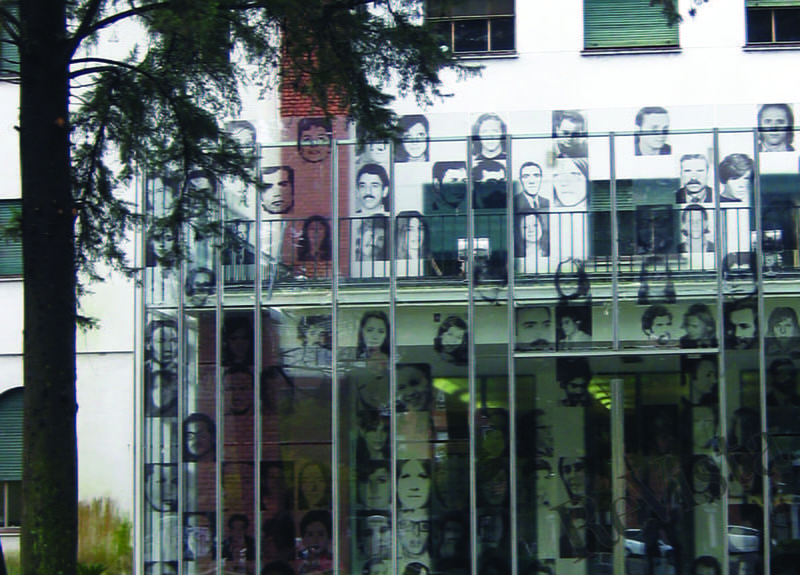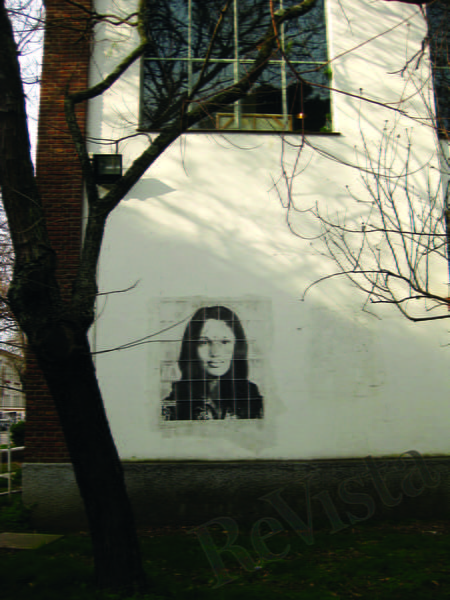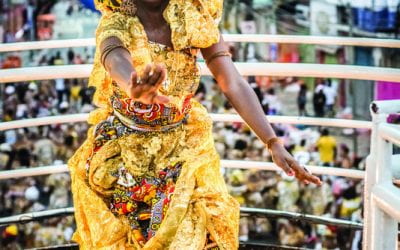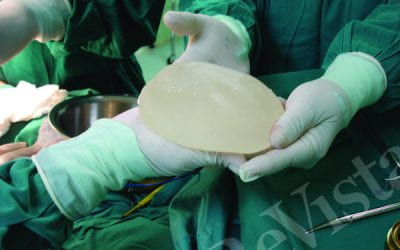Beauty in Places of Horror
Testimonies of Women Survivors of Clandestine Detention Centers in Argentina
Beauty is the last word that comes to mind when thinking about the state-run torture centers that proliferated under authoritarian regimes in Latin America during the 1970s and 80s. In Argentina, members of a repressive military dictatorship (1976-1983) kidnapped, tortured and forcibly disappeared massive numbers of people in more than 500 clandestine detention centers (CDCs). Thus, horror—not beauty—is more aptly associated with the events that took place in sites paradigmatic of state terrorism. Yet, my work with testimonies of women who survived clandestine detention reveals that beauty sometimes managed to sneak through the walls of prison. Beauty appeared both as an instrument of repression as well as something that could be reclaimed by women.
I listened to 52 women survivors whose oral testimonies were video-recorded and archived by the civil society association Memoria Abierta. During my research, this organization moved to the former ESMA (Escuela de Mecánica de la Armada/School of Naval Mechanics), where an emblematic clandestine detention center operated during the dictatorship. Part of my research, then, took place on the actual site of extreme suffering for thousands of people, most of whom did not survive. In the 2000s, as human rights organizations moved to the former ESMA site, the decaying building structures, the humid cold walls and the abandoned spaces underwent repair. Vestiges of the facility’s former self began to transform as archives, museums, cultural centers, and activist initiatives retooled ESMA as a site of memory, artistic production, education and promotion of human rights.
Day after day I immersed myself in Memoria Abierta’s Oral Archive, listening to the stories of women who survived state terror. These women’s narratives spoke of unimaginable atrocity and perversion at the hands of police, security and military forces. However, it was not just horror that these survivors wished to recount. Stories about detainees’ acts of care, solidarity and resistance were important in a number of narratives. There were also complex articulations of beauty, exposing both its oppressive and resistant face.
Through women’s accounts in Memoria Abierta, as well as other published testimonies, I learned how women dealt with beauty expectations that were woven into the very fabric of repression; I smiled when hearing about women who parodied beauty ideals while in captivity; and I was deeply moved by the accounts of former detainees who were able to find or create beauty in the midst of horror. As we shall see, these stories point to multiple meanings of beauty: the corporeal, associated with body features; the existential, related to the ability to understand the human condition; and the humanistic, linked to care and solidarity.
Iconic images of state terror—shackles, blindfolds, forced nudity, waterboarding or electric torture with the infamous picana—make it difficult to imagine beauty in any guise in clandestine detention centers. Some women talked about such insidious uses of the body as sexual violence. While women experienced violence regardless of bodily appearance, physical beauty was sometimes explicitly linked to such a threat. Survivor Marta Bianchi heard a repressor say, “how pretty [. . .] this one . . . we rape her” (Memoria Abierta, Testimonio de Marta Bianchi, Buenos Aires, 2006). In addition to the more recognizable rape varieties, including gang rape or rape in the context of torture, women experienced other forms of coerced sexual contact. Sometimes these sexual acts took place outside the camps, as when repressors took women to apartments or hotels for sexual purposes. In these situations, the possibility of “consent” was rendered meaningless; thus, these acts need to be understood as part of an oppressive repertoire in which the feminine body was merely an instrument.
In the book Ese Infierno (2001), women who survived captivity in ESMA spoke about how repressors would arrange pseudo dates with women detainees, taking them to restaurants and expecting them to appear conventionally beautiful, wearing feminine dresses and accessories. While most of the 5,000 people estimated to have been held in ESMA did not survive, the military implemented a so-called process of recuperación (recuperation/rehabilitation) of selected prisoners, prompting them to abandon their previous political views and allegiances. In the case of women, proper femininity was apparently part of the recuperation script, as also noted in Memoria Abierta’s book Y Nadie Quería Saber (2012). Marta Álvarez, one of many activist women held in ESMA, related how repressors realized that the activist woman “could think and develop her own ideas, and engage in political conversations, and discuss history, discuss politics, and discuss the economy. So, one had to find in that activist the feminine essence [. . .] That was the process of recuperation, at least with women: that we start doing ourselves up, that we start discovering motherhood, that we start talking about the kids” (Memoria Abierta, Testimonio de Marta Álvarez, La Lucila, Buenos Aires, 2007). Here we see that a bodily appearance in compliance with normative feminine beauty was part of a repressive mandate. The irony of this type of beauty in a torture camp did not escape another ESMA survivor, Elisa Tokar, who in the book Ese Infierno recalled the combination of “the smell of rats and the aroma of French perfume” (2001, 178). Military men at the camp supplied the perfume.
In listening to women’s testimonies, I learned that feminine beauty products, including makeup, hair removal wax and nail polish, became available in at least some of the camps. Relatedly, survivor Isabel Fernández Blanco also spoke about a kind of “rehabilitation” directed to some detainees in El Olimpo: in one of the offices of this CDC, “women painted their nails, combed their hair [. . . .] I suppose that the compañeras who were in charge of taking us out and bringing us to the GT2 Office were in charge of rehabilitating us, right? But nobody ever talked about politics either, or . . . anything. As I tell you, it was mere . . . nail painting” (Memoria Abierta, Testimonio de Isabel Fernández Blanco, Buenos Aires, 2005). As many of the detainees were activists, the absence of political talk and the presence of beauty practices is especially significant. The activist body was apparently to be replaced, in the case of women, by a domesticated, conventionally beautiful, feminine body.
Repressors sometimes used normative notions of femininity and beauty to humiliate and exacerbate the torment of women. The testimony of a survivor interviewed by Marta Diana in Mujeres Guerrilleras (1996, 49) is illustrative in that regard: “While they were torturing me they said: ‘You did not shave your hair . . .’ It is true, I was not waxed, and that hurt me more, that they touched my feminine dignity, than the torture per se, which was really hard. I still have the marks, third degree burns. But it was even more painful that they denigrated me as a woman.” While this woman held entirely different political views from her repressors, the fact that the torturers’ comments about her body were effective in augmenting her suffering exposes the power of cultural norms of femininity that can be used to discipline women through gender-shaming methods.
Survivor Graciela García said that it was at ESMA that some women started to engage in certain beauty practices, such as the removal of body hair and the use of cosmetics. The result contrasted with the look that Graciela described as typical for women in her activist circles: jeans, sneakers, and sweaters that were similar to the attire of activist men. Graciela explained how in a situation as grim as the one in the camps, it makes sense to look for something that “would make you smile.” She added: “I think that it was one of the first times that we used makeup, and waxed ourselves, and looked at the color of our hair” (Memoria Abierta, Testimonio de Graciela García, Buenos Aires, 2007). While many beauty practices function as disciplining mechanisms—and can be conceived as particularly oppressive when performed to live up to repressors’ expectations—Graciela also hinted at the pleasurable aspect of these practices, of this particular way of “caring” for the body in a place where the body was the site of torture, humiliation and pain. In its capacity to produce a smile, beauty could also acquire a more resistant meaning associated with survival.
In her contribution to the book Memories of Darkness (co-edited with Pedro P. Funari and Andrés Zarankin, 2009), Melisa Salerno observed how repressors turned familiar clothing items—detainees’ own garments—into instruments of torment (for example, to blindfold detainees or tie up their hands). Depriving captive people of their clothing, or giving them the clothes that belonged to others, was another way to attack their sense of personhood and identity. However, detainees sometimes were able to turn that logic around, using clothing for their own goals. Ana Di Salvo, who was captive in the detention center El Vesubio, remembered an anecdote involving a resistant use of clothing and the mocking of dominant notions of feminine beauty:
One time it was the birthday of one of the chicas [young women] who was there. So the ones who went to headquarters [. . .] brought a dress. And we gave it to her as a gift. And since it was her birthday, the guards let her show off her dress. Then she did a kind of fashion show, walking among the cuchas [prisoner cubicles; literally kennels]. And then, she said, “Ask me where I get my clothes.” So we said, “Where do you get your clothes?” [and she answered] “In the ‘Fuck Elegance Boutique’” [Boutique Me Cago en la Elegancia] [smiles]. And she walked, coming and going. Her name was Ofelia Casano, she was a medical doctor. When I left, she stayed, but did not survive. (Memoria Abierta, Testimonio de Ana Di Salvo, Buenos Aires, 2003)
This passage reveals how a parody of conventional femininity and of the beauty norms of the upper class (the boutique, the presumably elegant fashion show) functioned as an oppositional practice in an utterly oppressive setting. The collective dimensions of the scene are also apparent: the sense of solidarity, the kindness embedded in the group’s gift of clothing, and the creation of a space of shared laughter. These women were able to negotiate and take advantage of whatever opening was available within an overwhelming structure of terror. We can thus see how certain beauty practices were among the tactics to survive and resist that emerged in clandestine detention, something that some survivors had a particular interest in highlighting. For instance, Cristina Comandé said that instead of talking about the details of torture, she wished to do something different: “to emphasize the solidarity and support that I received from and gave to my compañeros [comrades/fellow detainees]” (Memoria Abierta, Testimonio de Cristina Comandé, Buenos Aires, 2005). Sadly, as the story of the gift of clothing and the mock runway illustrates, though detainees’ acts of mutual care went a long way in sustaining body and soul, the lives of countless people were not spared.
Some of the ways in which detainees coped with and resisted the extreme conditions of the camps evoke a deeper meaning of beauty, beyond corporeal traits and appearance. Marta García de Candeloro, who spent six months detained in La Cueva, experienced and witnessed all manner of violence and terror; yet, she also mentioned beauty explicitly: “Everything else is already in my testimony, everything else is the horror, and everything else also has great beauty. It seems strange, no?, to say that all that . . . but it has the beauty of knowing what a human being is, what our limits are, what it means to want to live and to be able to live” (Memoria Abierta, Testimonio de Marta García de Candeloro, Mar del Plata, Buenos Aires, 2007). Here Marta finds beauty in the ability to understand the human condition, which includes the personal strengths and support that human beings might discover even in the ugliest of situations. This existential connotation of beauty also resonates with a humanistic meaning implicitly conveyed through survivors’ testimonies of care and solidarity, for they point to the ethical and aesthetic value of positive human connections that were integral to survival. In her book On Beauty and Being Just (1999), Elaine Scarry points out that beauty has a way of proliferating itself, reflected in the common impulse to reproduce what is beautiful. Similarly, there is beauty in solidarity, which already entails a multiplicative quality in the ways it generates additional acts of support. Further, Scarry reasons that “beauty is lifesaving” (24) or at least “life affirming” (27). The beauty of solidarity in the form of a poem, a shared piece of bread, a consoling song, or a helping hand sustained lives in very real ways in torture and extermination camps.
Clandestine detention centers were, no doubt, spaces of sheer horror. When repressors introduced anything remotely associated with beauty—particularly in relation to women’s bodies—it was often to enhance their own power. One may wonder, for example, why would state representatives be invested in how women looked—beyond the sexual desires of individual repressors? To what extent were beauty norms outside the camps used to intensify oppression within their walls? State power was manifested partly through repressors’ ability to impose gender norms and exploit gender inequalities in clandestine detention centers. And still, a lens that places vulnerability and agency within the same frame allows us to see how gendered beauty practices could also become instruments of survival and resistance for some women. What’s more, the ability of survivors to excavate beauty—in its most profound meanings—from the grounds of horror speaks not only of physical survival, but of the survival of a dignified and resistant stance that the regime could not crush.
The translation of all texts and testimonies originally in Spanish were done by the author.
Spring 2017, Volume XVI, Number 3
Barbara Sutton is Associate Professor of Women’s, Gender, and Sexuality Studies at the University at Albany, SUNY. Her book, Bodies in Crisis, won the 2011 Gloria E. Anzaldúa Award by the National Women’s Studies Association. Her forthcoming book, Surviving State Terror, is slated for publication with NYU Press.
Related Articles
Contesting Beauty
English + Español
In 2016, the official Miss Brazil beauty pageant competition witnessed an unprecedented moment, as six black Brazilian women from around the country advanced to…
Should I Eat the Chocolate Cake?
English + Español
When people learn that I research the representation of food and weight in Latin American women’s literature, they frequently ask me two questions. The first question is how I became interested in such an untraditional topic…
Technologies of Gender
It was a Tuesday afternoon in early June 2005, and I was sitting with well-known cosmetic surgeon Dr. Julien Martinez (a pseudonym to protect participant confidentiality) in his spa…






